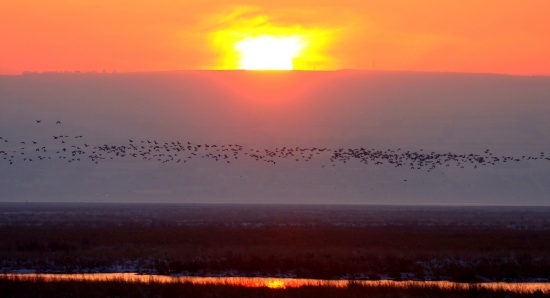| This article is incomplete. This article is missing one or more sections. You can help the BirdForum Opus by expanding it. |
Overview
This reserve covers a large part of the eastern side of the Dee Estuary and consists of extensive areas of saltmarsh with numerous creeks, below which are large areas of inter-tidal mudflats. In addition there is a reedbed by the shore at Neston.
Birds
Notable Species
Although there are breeding Common Shelduck, Oystercatcher and Common Redshank and the reedbed at Neston has breeding warblers, the importance of this reserve lies in the large numbers of wintering and passage waterfowl and waders.
A large colony of Black-headed Gull occur here throughout the spring/summer and often contain the odd Mediterranean Gull.
Ducks occurring here include Eurasian Wigeon, Common Teal and this is an outstanding site for Northern Pintail. Waders occur in very large numbers and species such as Oystercatcher, Black-tailed Godwit, Grey Plover, Red Knot, Dunlin, Eurasian Curlew and Common Redshank are always present in autumn and winter.
The saltmarshes also attract finches and Chaffinch, Greenfinch, Linnet and Reed Bunting. Brambling and Twite are also often present.
Attracted by the vast wintering flocks are Short-eared Owl, Hen Harrier, Merlin and Peregrine Falcon.
The reedbed at Neston Neston Reedbed is the largest area of reeds on the estuary and is home to the largest population of Reed Warbler anywhere on the estuary. Cetti's Warbler are also possible in this area and the past few winters have seen several records.
Check-list
Birds you can see here include:
Great Cormorant, Common Shelduck, Eurasian Wigeon, Common Teal, Mallard, Northern Pintail, Greater Scaup, Long-tailed Duck, Hen Harrier, Eurasian Sparrowhawk, Common Kestrel, Merlin, Peregrine Falcon, Eurasian Oystercatcher, Ringed Plover, Grey Plover, Red Knot, Sanderling, Curlew Sandpiper, Purple Sandpiper, Dunlin, Ruff, Jack Snipe, Black-tailed Godwit, Bar-tailed Godwit, Eurasian Curlew, Spotted Redshank, Common Redshank, Common Greenshank, Ruddy Turnstone, Black-headed Gull, Common Gull, Lesser Black-backed Gull, European Herring Gull, Great Black-backed Gull, Short-eared Owl, Western Barn Owl, Little Owl, Common Kingfisher, Eurasian Skylark, Meadow Pipit, Common Grasshopper Warbler, Sedge Warbler, Common Reed Warbler, Chaffinch, Brambling, European Greenfinch, Eurasian Linnet, Twite, Reed Bunting, Little Egret, Grey Heron, Water Rail
Other Wildlife
A great variety of small mammals can be seen when high tides flood the marshes.
Site Information
Areas of Interest
There are good viewpoints from a footpath adjacent to the Boathouse Restaurant and from the 'Old Baths' car park which is reached by driving along the lane in front of the Boathouse.
Access and Facilities
Gayton Sands can be viewed from Parkgate, reached on the B5135 road from the A540 Chester-Hoylake road.
Grid reference: SJ273789
Contact Details
Tel: 0151 3367681 (RSPB.)
External Links
Content and images originally posted by Steve




